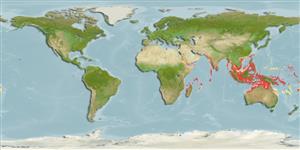Environment: milieu / climate zone / depth range / distribution range
นิเวศวิทยา
เกี่ยวกับทะเล,น้ำเค็ม เกี่ยวกับหินโสโครก; ไม่มีการอพยพย้ายถิ่น; ระดับความลึก 1 - 60 m (Ref. 90102). Tropical; 25°N - 25°S
Indo-West Pacific: East coast of Africa, throughout Indonesia and New Guinea to New Caledonia, north to southern Japan.
ขนาด / น้ำหนัก / Age
Maturity: Lm ? range ? - ? cm
Max length : 45.0 cm TL เพศผู้/กระเทย; (Ref. 9710)
เงี่ยงครีบหลัง (รวม): 13; ก้านครีบอ่อนที่หาง (รวม): 20-21; เงี่ยงครีบก้น 3; ก้านครีบอ่อนที่ก้น: 20.
Inhabits coastal reefs to at least 30 m (Ref. 9710). Adults often found in pairs inside caves (Ref. 9710, 48636). Juveniles settle in very shallow inshore habitats with short filamentous algae growth on rock or dead coral substrates (Ref. 48636). Feeds on sponges and tunicates (Ref. 48391). Undergoes a complete color transformation from the juvenile to adult stage. Regularly exported, e.g. from Sri Lanka, for the aquarium trade.
Life cycle and mating behavior
วัยเจริญพันธุ์ | การสืบพันธุ์ | การวางไข่ | เซลสืบพันธ์ของเพศเมีย(ไข่) | ความดกของไข่ | ตัวอ่อน
Steene, R.C., 1978. Butterfly and angelfishes of the world. A.H. & A.W. Reed Pty Ltd., Australia. vol. 1. 144 p. (Ref. 4859)
IUCN Red List Status (Ref. 130435)
Threat to humans
Harmless
Human uses
การประมง: ไม่มีผลประโยชน์; สถานที่แสดงสัตว์และพืชน้ำ: การค้า
ข้อมูลเพิ่มเติม
ชื่อสามัญชื่อพ้องกลไกการเผาผลาญพลังงานผู้ล่าการศึกษาเกี่ยวกับผลกระทบของสารประกอบทางเคมีที่เป็นอันตรายต่อสิ่งมีชีวิต ประชากร และสิ่งแวดล้อมการสืบพันธุ์วัยเจริญพันธุ์การวางไข่การรวมกลุ่มวางไข่ความดกของไข่เซลสืบพันธ์ของเพศเมีย(ไข่)Egg development
อ้างอิงการเพาะเลี้ยงสัตว์น้ำประวัติการเพาะเลี้ยงสัตว์น้ำสายพันธุ์พันธุศาสตร์ElectrophoresesอัตราพันธุกรรมโรคการแปรรูปNutrientsMass conversion
เครื่องมือ
Special reports
Download XML
แหล่งที่มาจากอินเตอร์เน็ต
Estimates based on models
Preferred temperature (Ref.
123201): 26.3 - 29.1, mean 28.3 °C (based on 1202 cells).
Phylogenetic diversity index (Ref.
82804): PD
50 = 0.5001 [Uniqueness, from 0.5 = low to 2.0 = high].
Bayesian length-weight: a=0.03236 (0.01300 - 0.08052), b=2.89 (2.71 - 3.07), in cm total length, based on LWR estimates for this Genus-body shape (Ref.
93245).
ระดับชั้นอาหาร (Ref.
69278): 2.6 ±0.00 se; based on food items.
ความสามารถในการกลับคืนสู่ปกติ (Ref.
120179): ต่ำมาก, เวลาต่ำสุดที่จะทำให้ประชากรเพิ่มขึ้นเป็น 2 เท่าใช้เวลามากกว่า 14 ปี (Preliminary K or Fecundity.).
Fishing Vulnerability (Ref.
59153): Low to moderate vulnerability (35 of 100).
Nutrients (Ref.
124155): Calcium = 38.1 [18.7, 64.7] mg/100g; Iron = 0.502 [0.301, 0.834] mg/100g; Protein = 18.2 [16.9, 19.4] %; Omega3 = 0.0899 [, ] g/100g; Selenium = 37.8 [19.9, 73.4] μg/100g; VitaminA = 54.3 [13.1, 209.4] μg/100g; Zinc = 1.29 [0.89, 1.85] mg/100g (wet weight);
